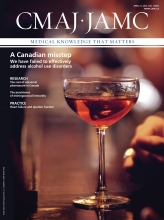See also page 518 and www.cmaj.ca/lookup/doi/10.1503/cmaj.140430
A 70-year-old woman was referred to her family physician by the emergency department for follow-up of shortness of breath, orthopnea and swelling of her legs that she had experienced for two months. She had no other symptoms and was taking amlodipine 10 mg daily and lisinopril 10 mg daily for hypertension. On physical examination, her blood pressure was 160/92 mm Hg and pulse rate was 70 beats/min. Estimated central venous pressure was 12 (normal ≤ 8) cm H2O. Cardiac examination was unremarkable, and there were bibasilar crackles on lung auscultation. She had bilateral pedal pitting edema. In the emergency department, test results for electrolyte levels and renal function were within normal limits. An electrocardiogram showed sinus rhythm and left ventricular hypertrophy. An echocardiogram showed an ejection fraction of 56%, concentric left ventricular hypertrophy with no substantial valvular abnormalities, and grade III diastolic dysfunction.
What is the diagnosis?
Based on the presenting symptoms and examination findings, the clinical syndrome of heart failure was diagnosed. Heart failure is a clinical diagnosis. Once the diagnosis is made, ejection fraction measured by echocardiography helps to distinguish between different types of heart failure (Box 1).1
| Ejection fraction, % | Diagnosis in patients with clinical heart failure |
|---|---|
| ≥ 50 | Heart failure with preserved ejection fraction |
| 41–49 | Heart failure with borderline preserved ejection fraction |
| ≤ 40 | Heart failure with reduced ejection fraction |
Diagnosis of heart failure with preserved ejection fraction is challenging, because other potential causes of symptoms have to be excluded. Most patients with heart failure with preserved ejection fraction have evidence of abnormal left ventricular diastolic function on Doppler echocardiography.1,2 In the past, heart failure with preserved ejection fraction was commonly called “diastolic heart failure.” Because left ventricular diastolic dysfunction is seen not only in patients with heart failure with preserved ejection fraction, but also in those with heart failure with reduced ejection fraction, “heart failure with preserved ejection fraction” has replaced “diastolic heart failure.”1,3 About 40%–70% of patients with clinical heart failure have heart failure with preserved ejection fraction.1 Among the patients admitted to hospital with decompensated heart failure, the proportion of those with heart failure with preserved ejection fraction has been increasing over the last 15 years.4,5
Heart failure with preserved ejection fraction and heart failure with reduced ejection fraction are two distinct syndromes and do not represent a continuous spectrum of disorder. They differ in several aspects, including pathophysiology, patient population and treatment modalities.1,2 Pathophysiology of heart failure with preserved ejection fraction is related to diastolic dysfunction, and major predictors are left ventricular relaxation and stiffness.2,3
Our patient had clinical features of heart failure but had normal left ventricular ejection fraction, and therefore was given the diagnosis of heart failure with preserved ejection fraction.
What risk factors may have contributed to heart failure in this patient?
The major predictors of heart failure with preserved ejection fraction are hypertension, atrial fibrillation, older age, female sex, coronary artery disease, obesity, diabetes and hyperlipidemia.1 Of these risk factors, hypertension is the most frequent, with prevalence of up to 90%.1,2 Also, heart failure with preserved ejection fraction is associated with multiple noncardiac comorbidities, such as chronic kidney disease, lung disease, anemia, liver disease and thyroid diseases.
Our patient had a history of long-standing hypertension, which likely contributed to the development of heart failure with preserved ejection fraction.
What treatment options should be considered for this patient?
Treatment for patients with heart failure with preserved ejection fraction mainly involves risk-factor modification and treatment of associated comorbidities.1,2 Because trial data are limited, strict control of blood pressure and other comorbidities remain the mainstay of management.1,2 To date, no treatment has been shown to improve mortality in these patients.
Although angiotensin-converting enzyme inhibitors and β-blockers have not shown a mortality benefit in patients with heart failure with preserved ejection fraction, they should be used if indicated for comorbid conditions, such as hypertension, coronary artery disease and chronic kidney disease.1 Because hypertension, tachycardia and coronary ischemia could cause decompensation of heart failure, these conditions should be treated according to guidelines, including coronary intervention if needed.1–3
Diuretics are used for symptomatic patients with volume overload. In the recently reported Treatment of Preserved Cardiac Function Heart Failure with an Aldosterone Antagonist (TOPCAT) study, spironolactone did not decrease mortality, but was noted to decrease the rate of hospital admissions for heart failure.6
Lifestyle modification with exercise training has been shown to improve quality of life in these patients.2,7 Adherence to medication should be emphasized, and patients with multiple comorbidities should be enrolled in programs for heart failure management if available.1,2
What follow-up does this patient require?
Patients with heart failure with preserved ejection fraction should receive follow-up like those with heart failure with reduced ejection fraction. Although mortality for heart failure with preserved ejection fraction may be lower than that for heart failure with reduced ejection fraction, studies show that the rate of heart failure–related hospital admissions among patients with heart failure with preserved ejection fraction is similar to the rate among patients with heart failure with reduced ejection fraction.2,8 An efficient system of coordinated care, active patient education and appropriate follow-up is recommended for all patients with heart failure with preserved ejection fraction.1,2
Case revisited
The patient was advised to increase her lisinopril dose to achieve better blood pressure control, and she was also started on spironolactone. At two weeks’ follow-up, her shortness of breath was better and her blood pressure was 138/82 mm Hg. She was referred to a heart failure clinic for follow-up.
Footnotes
Competing interests: None declared.
This article has been peer reviewed.
Contributors: Both of the authors equally contributed to the drafting and revision of the manuscript, and gave final approval of the version submitted for publication.











